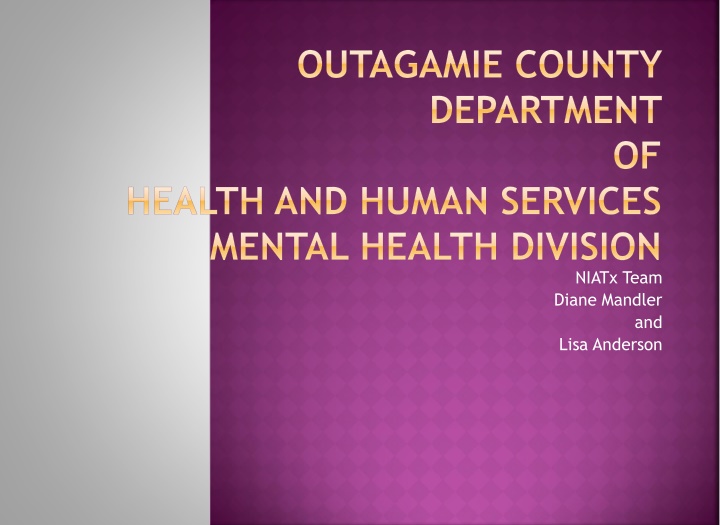
Innovative Approaches to Mental Health Services in Outagamie County
Explore how Outagamie County Department of Health and Human Services is revolutionizing mental health care with a focus on suicide prevention, reducing wait times, and enhancing client outcomes through the Perfect Depression and Priority Access models. Discover the results, lessons learned, and the team's dedication to advancing mental health services.
Download Presentation

Please find below an Image/Link to download the presentation.
The content on the website is provided AS IS for your information and personal use only. It may not be sold, licensed, or shared on other websites without obtaining consent from the author. If you encounter any issues during the download, it is possible that the publisher has removed the file from their server.
You are allowed to download the files provided on this website for personal or commercial use, subject to the condition that they are used lawfully. All files are the property of their respective owners.
The content on the website is provided AS IS for your information and personal use only. It may not be sold, licensed, or shared on other websites without obtaining consent from the author.
E N D
Presentation Transcript
OUTAGAMIE COUNTY DEPARTMENT OF HEALTH AND HUMAN SERVICES MENTAL HEALTH DIVISION NIATx Team Diane Mandler and Lisa Anderson
DATA AND AIM BASELINE DATA 2013: 7 Clients died by suicide Outpatient wait list: 6 weeks for a psychiatrist and 4 weeks for a therapist. ORIGINAL AIM Reduce client suicide rate from 7 to 0. SECONDARY AIM Shorten outpatient waitlist from weeks to days.
CHANGE FOR PRIMARY AND SECONDARY AIMS PERFECT DEPRESSION MODEL Next day follow up Weapons/means restriction Family Involvement Adverse Event Analysis Zero suicide philosophy PRIORITY ACCESS MODEL (P.A.M) For clients with a moderate or severe level of need, screened by Crisis Phone Staff. Priority Access appointments available Monday-Friday. Outpatient and Crisis Therapist share responsibility for schedule Schedule appointment with psychiatrist and therapist at time of PAM appointment.
RESULTS PERFECT DEPRESSION MODEL SURVEY Pretest, Post-test and Re-test Do you think suicide can be prevented? Strongly Agree Agree Neutral Disagree Strongly Disagree 18% 32% 11% 0 3% 57% 56% 4% 0 0 40% 56% 15% 8% 0 Do you believe that some people will attempt suicide no matter what Strongly Agree Agree 51% Neutral 8% Disagree 15% Strongly Disagree 26% 3% 34% 37% 0 0 20% 20% 36% 26% 4% 20% Seeking collateral information on people who are suicidal is important Strongly Agree Agree 25% Neutral 3% Disagree 13% Strongly Disagree 54% 28% 0 4% 5% 64% 16% 0 0 4% 84% 0 Most individuals who are suicidal are ambivalent about attempting suicide Strongly Agree Agree 25% Neutral 3% Disagree 13% Strongly Disagree 54% 28% 0 4% 5% 64% 16% 0 0 4% 84% 0
RESULTS PRIORITY ACCESS MODEL Decreased wait list time Reduced hospitalizations Increased client and staff satisfaction Decreased no show rate from 50% to 11% Increased revenue
LESSONS LEARNED PERFECT DEPRESSION MODEL Remind staff to ask about means restriction, especially firearms. Continue to educate staff regarding the philosophy of zero depression PRIORITY ACCESS MODEL Easier to start than believed by administration and staff. Some staff struggle with change and expect resistance Move forward no matter what
NEXT STEPS PERFECT DEPRESSION MODEL Begin to collaborate with community to decrease suicide rate Nurture stronger belief in zero suicide as a goal. PRIORITY ACCESS MODEL Start walk-in clinic for increased access to services Survey clients to determine level of satisfaction
